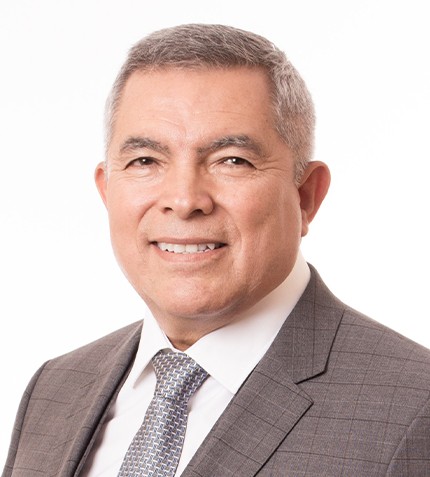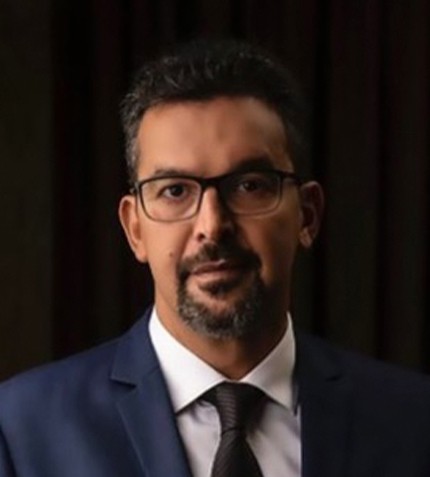
“Plant renovations at La Coipa are currently focused on the crushing, grinding, leach pads, refinery, filtration and tailings areas, making sure critical components are complete to start first-stage production and move towards full operating capacity by the middle of 2022.”
Rolando Cubillos
VICE-PRESIDENT & GENERAL MANAGER, KINROSS CHILE
Can you provide an overview of Kinross’ La Coipa, Lobo Marte and Maricunga operations in Chile?
With the La Coipa, Lobo Marte and Maricunga mines, Kinross has contributed significantly to the evolution of sustainable mining in Chile, through safe, sustainable and profitable management that protects the environment and is responsible with its communities in which we are inserted.
La Coipa is located about 140 km northeast of Copiapó, in northern Chile, and has now begun to take firm steps towards reopening with the exploration of the Phase 7 deposit, after a Partial Temporary Stoppage (PTP) for eight years. Meanwhile, Lobo Marte, a gold deposit located 160 km east of Copiapó at an approximate height of 4,200 m above sea level, will be responsible for providing operational continuity to Kinross in Chile. Finally, Maricunga has been in the Partial Temporary Stoppage (PTP) stage since 2016 when mining and crushing activities were suspended, and this project continues to comply with the environmental obligations contracted in its Environmental Qualification Resolutions.
Which refurbishments are being made to ensure full operating capacity is reached at La Coipa?
On February 1, 2022, the La Coipa process plant restarted its operations, after a year of mechanical maintenance, rehabilitation of electrical systems and instrumentation, as well as restitution of the equipment that had been preserved since 2013, when the PTP was completed. With this start-up, the reopening project continues to make excellent progress, according to the work plans that, initially, contemplate the start-up of the mine with an operating line that includes the conveyor belt, part of the tanks and the SAG and ball mills.
In November 2021, the mine operations area inaugurated the mining road on which they have worked since January 2021, to connect the Phase 7 pit with the primary crusher of the 15,000 tonnes per dy (t/d) plant. Around 14 million tonnes of ore will be transported along said road during the life of this project, through a 5.5 km route with an effective width of 35 meters, which starts at Cota 4140.
Plant renovations are currently focused on the crushing, grinding, leach pads, refinery, filtration and tailings areas, making sure critical components are complete to start first-stage production and move towards full operating capacity by the middle of 2022.
What were the highlights from the feasibility study published for the Lobo Marte project?
One of the most outstanding aspects in the Feasibility Study (FS) for Lobo Marte were the substantial improvements made to the Environmental Impact Study presented in 2011, since they show a contemporary vision of the mining company, from the social, environmental and operational point of view. Special emphasis has been given to the incorporation of environmental and community considerations as part of the project design, which has had the constant participation of the various stakeholders. The purpose is to adapt to the local environment, protecting water resources and biodiversity in general.
According to the FS, the project schedule will be linearly linked to the end of La Coipa, providing greater flexibility for its start-up, which could take place towards the end of this decade. Meanwhile, Kinross continues to work on activities aimed at obtaining permits and the EIA. This project is expected to extract 4.7 million ounces of gold over a mine life of 16 years.
Can you explain how Kinross Chile is modernizing its Chilean operations through technology?
We are currently working on several fronts to move towards modernizing our processes, such as the incorporation of a Respa air purification system, which works exactly the same as the one currently used by commercial aeronautics. This system was installed in mining equipment at La Coipa to considerably improve the air quality inside the cabins and prevent workers from coming into contact with dust.
In addition to that, we have a new FAM mobile tailings stacker, imported from Germany, which allows the operator to work in an automated and remote manner on the 500-meter-long structure mounted on 11 caterpillar tracks, thus allowing for a safer operation.
How is Kinross supporting local development in Chile?
One of the fundamental values of Kinross is that people come first. Based on that premise we have focused, throughout more than 30 years of operation, on contributing effectively to the local development of our neighboring communities. In this sense, we have established alliances, not only with the Production Development Corporation (CORFO), with which we develop joint projects such as the embellishment of the Paipote entrance and the integrated monitoring of high Andean wetlands in the Salar de Maricunga basin, but also with the Regional Ministry of Cultures, Arts and Heritage of the Atacama Region, with which we have a 10-year cultural collaboration agreement.
Similarly, for 30 years we have contributed annually to university students through the Kinross Scholarship, supporting San Lorenzo, one of the most important schools in Copiapó.
We must also mention the permanent collaboration that we have developed over time with the different government authorities during the history of Kinross in the Atacama region, which has the purpose of establishing a human approach to mining management in the territory.
What is Kinross Chile’s outlook for the next five years?
One of our main objectives is to be recognized as an honest, responsible, credible company that makes a great contribution to the sustainable development of the communities where we operate. We believe that working for long-term operational continuity, being efficient in the optimization of resources and responsible with our neighbors and biodiversity, will achieve the results we have always expected.










